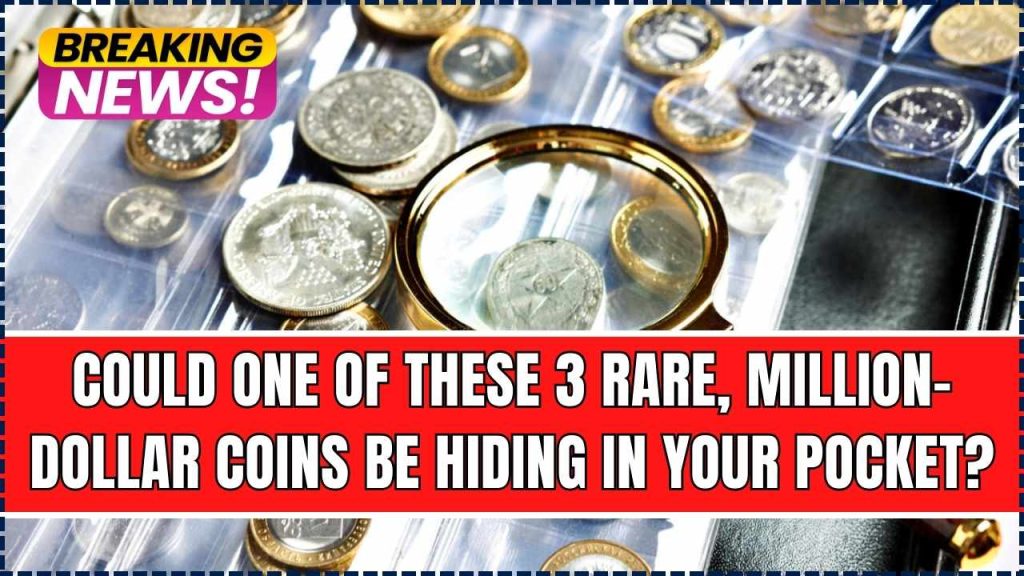
Could One of These 3 Rare: Imagine discovering that a simple coin in your pocket is worth thousands—or even millions—of dollars. It might sound like a dream, but for a lucky few, this scenario has turned into reality. Rare coins with historical significance, unique features, or minting errors can fetch staggering prices at auctions, and some of these treasures could be hiding in plain sight. Let’s delve deeply into three rare coins that might just be waiting to be discovered in your change jar—and explore how you can identify them, their rich histories, and their astonishing values.
Could One of These 3 Rare Million-Dollar Coins
| Coin Name | Estimated Value | Key Characteristics |
|---|---|---|
| 1915 Buffalo Nickel | $240,000+ | Low mintage; proof version with unique tone |
| 1916 Mercury Dime | $152,750+ | ‘D’ mint mark; full bands on reverse |
| 1982 Lincoln Penny | $18,800+ | Small date design; Denver mint mark; specific weight |
From the 1915 Buffalo Nickel to the 1982 Lincoln Penny, rare coins hold the potential to turn everyday pocket change into extraordinary treasures. While the odds of finding one are slim, regularly checking your coins and staying informed about what to look for can make all the difference. Whether you’re a seasoned collector or a curious beginner, the thrill of the hunt and the stories behind these coins make numismatics a fascinating pursuit.
1. The 1915 Buffalo Nickel
What Makes It Special?
The Buffalo nickel, minted from 1913 to 1938, is one of the most iconic coins in U.S. history. A rare 1915 proof version of this coin recently sold for over $240,000 at auction. Only 1,050 proof coins were struck at the Philadelphia Mint that year, making them highly desirable among collectors.
The coin’s distinctive design and the cultural symbolism it represents have made it a cherished artifact of early 20th-century America. It commemorates the country’s frontier spirit and respect for Native American heritage, making it far more than a piece of currency.
Unique Features
- Design: The obverse features a Native American profile, modeled from a composite of three tribal chiefs, while the reverse displays an American buffalo, believed to be based on a Central Park Zoo bison named Black Diamond.
- Condition: Proof versions have a mirror-like finish, and those in near-perfect condition command the highest prices.
- Tone: Unique colorations, such as golden or rainbow hues, can further enhance the coin’s value and appeal to collectors.
Cultural Significance
The Buffalo nickel symbolizes the United States’ respect for its natural history and indigenous peoples. Its imagery is a celebration of resilience and strength, which is why collectors view it as more than just a monetary artifact.
2. The 1916 Mercury Dime with ‘D’ Mint Mark
Why It’s So Valuable
The Mercury dime, officially known as the Winged Liberty Head dime, is another highly sought-after coin. The 1916 version with a ‘D’ mint mark (produced in Denver) is particularly rare, with only 264,000 minted. This low mintage makes it one of the rarest regular-issue dimes in U.S. history.
Coins from this year that also feature “full bands” on the reverse side—indicating a strong and detailed strike—are especially valuable. Full bands refer to the clearly visible, unbroken horizontal lines on the bands around the torch on the coin’s reverse. Coins in this condition are incredibly scarce.
Identify It
- Mint Mark: Look for the ‘D’ on the reverse side, near the base of the torch. It distinguishes Denver-minted coins from others.
- Full Bands: Check the bands around the torch on the reverse side. If all bands are fully visible and unbroken, the coin’s value significantly increases.
- Condition and Auction Records: A pristine example of this coin has fetched upwards of $152,750, with rarer specimens valued even higher.
Design and Legacy
The Mercury dime’s elegant design, with Lady Liberty donning a winged cap symbolizing freedom of thought, captures the optimism and artistic spirit of its era. Its name—inspired by its resemblance to the Roman god Mercury—reflects the coin’s enduring allure.
3. The 1982 Lincoln Penny with Small Date and ‘D’ Mint Mark
Why You Should Check Your Change
Pennies might seem inconsequential, but certain 1982 Lincoln pennies are worth a small fortune. This specific penny, featuring a “small date” design and a Denver mint mark, is valued at $18,800 or more under the right conditions. Its significance lies in the transition period when the U.S. Mint switched from bronze to zinc composition for pennies, creating several variations.
Key Characteristics
- Small Date: The smaller and thinner numerals on the “1982” date are noticeably different from the regular date design.
- Weight: Pennies minted in 1982 were struck in both bronze (3.1 grams) and zinc (2.5 grams). The bronze version is more valuable due to its rarity.
- Mint Mark: The ‘D’ indicates production at the Denver Mint. Coins with both the small date design and the heavier bronze composition are the most sought after.
Importance in Numismatics
The 1982 Lincoln penny exemplifies how small design changes and transitional minting periods can create highly valuable collectibles. These coins intrigue both novice and seasoned collectors due to their unique place in minting history.
Identify Valuable Coins in Your Pocket Change
1. Examine the Date and Mint Mark
Carefully inspect coins for the specific years and mint marks mentioned above. Coins with limited production runs or unique minting errors are often the most valuable.
2. Assess the Condition
- Grading: Coins are graded on a scale from Poor (P-1) to Mint State (MS-70). Higher grades mean higher value. Proof coins or those with minimal wear and sharp details are the most prized.
- Wear and Tear: Check for clear details, original luster, and minimal surface damage.
3. Look for Unique Features
- Proof Coins: These are specially struck for collectors and often have a mirror-like finish.
- Errors: Misprints, double strikes, or off-center designs can make a coin more valuable.
- Full Bands and Toning: Details like full bands on a dime or unique coloration patterns can add significant value.
$3,800 One-Time Check from SSA in January 2025: Who Qualifies and When?
SSI, SSDI, and Retirement: January 2025 Social Security Payment Schedule Revealed
SNAP Beneficiaries to Get Additional Payments on EBT Cards in January 2025!
What to Do If You Find a Rare Coin
1. Authenticate the Coin
Before celebrating, have the coin authenticated by a reputable grading service like the Professional Coin Grading Service (PCGS) or the Numismatic Guaranty Company (NGC). Authentication ensures the coin’s legitimacy and determines its grade.
2. Determine Its Value
Consult auction results, price guides, or certified coin dealers to estimate the coin’s current market value. Websites like PCGS provide free price guides and auction records for reference.
3. Explore Selling Options
- Auctions: Rare and high-value coins often sell for the best prices at reputable auction houses.
- Dealers: Certified coin dealers can offer a quick sale, though prices may be slightly lower than at auctions.
- Online Platforms: Consider selling on platforms like eBay, but ensure proper authentication to attract serious buyers and avoid counterfeit concerns.
FAQs On Could One of These 3 Rare Million-Dollar Coins
1. Can I find rare coins in circulation?
Yes, while the chances are slim, valuable coins can occasionally be found in pocket change, bank rolls, or old collections.
2. How can I learn more about rare coins?
Join organizations like the American Numismatic Association or explore online resources from PCGS and NGC to deepen your understanding.
3. Are rare coins a good investment?
Rare coins can appreciate in value over time, but they should be collected primarily for enjoyment rather than as a guaranteed investment.
4. How can I avoid counterfeit coins?
Buy from reputable dealers and insist on certifications from recognized grading agencies. Avoid deals that seem too good to be true.
5. What if I inherit a coin collection?
Have it appraised by a professional numismatist to determine its value and identify any rare or valuable pieces.

